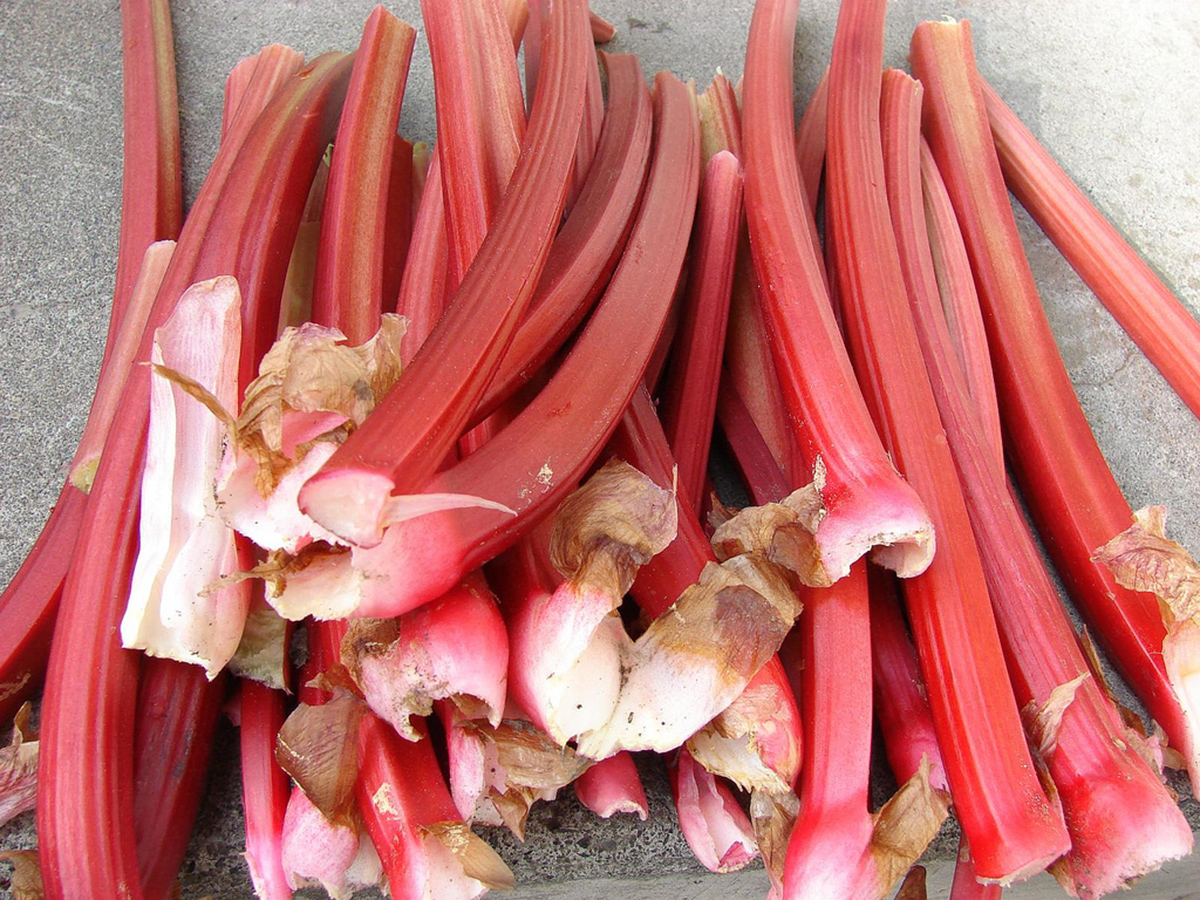Table of Contents
5. Rhubarb
Millions of Americans who listen to public radio are familiar with Garrison Keillor's ode to rhubarb pie, "One little thing can revive a guy, and that is a piece of rhubarb pie / Serve it up, nice and hot / Maybe things aren't as bad as you thought. Momma's little baby loves rhubarb rhubarb, Be-Bop-A-Re-Bop Rhubarb Pie" to the tune of "Shortnin' Bread." The versatile rhubarb plant, which requires cold winters, is a source of laxatives (the root), poison (the leaves), and dessert (the stems). It's important never to eat the roots or leaves due to their unpleasant toxic effects. Rhubarb stems, however, are stewed with sugar to make desserts, or they can be used as a side dish without sugar or to make pickles. Don't eat rhubarb from your own garden if it has been severely damaged by cold, and avoid the plant if you have kidney stones.

6. Garlic scapes
Garlic scapes are the green stems that grow above the garlic bulb. You probably won't ever see them unless you harvest garlic from your own garden or shop at an Asian market. The green shoots don't have the same intense "garlicky" flavor as the bulb itself, and can be eaten as a green vegetable or added to soups and casseroles. Use them in stir-fry, or to make pesto.
7. Jerusalem artichokes
Jerusalem artichokes are a commonly misunderstood vegetable. They aren't really artichokes at all. They are the underground stems of a species of sunflower. And their principal carbohydrate is inulin, not as some suggest, insulin. Inulin feeds the probiotic bacteria that grow in your colon. A small amount of peeled Jerusalem artichoke shaved into your salad adds crunch and a slightly sweet flavor to a salad. A large serving of Jerusalem artichoke will usually give you gas.
8. Romanesco cauliflower
The green, yellow, or purple Romanesco cauliflower (also known as Romanesco broccoli, actually a variety of cabbage) is denser than cauliflower but not quite as sulfur-smelling as broccoli. The vegetable is usually prepared by steaming, although it can also be roasted with fingerling potatoes and served as a side dish. Romanesco cauliflower is more difficult to prepare as 'cauliflower mashed potatoes" than regular cauliflower because it is harder to get all the little green bits that mar the "potato" flavor of the dish.
9. Dandelion
Dandelion greens are rich in calcium, potassium, vitamin C, and vitamin A. They are a highly nutritious addition to a spring salad. Just don't use dandelion greens that have been sprayed with herbicide.
Dandelion roots can be used to make a spring tonic or "dandelion wine," but avoid this elixir if you have gallbladder disease. Dandelion root can stimulate the production of bile that places pressure on gallstones.
10. Okinawan purple sweet potatoes
My personal favorite, of course, is the Okinawan purple sweet potato, a round underground tuber with a purple flesh. Some "purple" sweet potatoes actually have white flesh, but both varieties are delicious as a side dish or even as the basis of a dessert, such as ice cream. Purple sweet potatoes have a unique, nutty flavor, and are a terrific source of folate, potassium, and anthocyanins.
See Also: Maitake Mushrooms: A Real Culinary Treat
Still looking for a unique vegetable? Try one of the favorite foods of Eastern Asia, the bitter melon. In small servings, this aptly named bitter vegetable, served steamed or in stir fries, helps lower blood sugar and blood pressure--but don't eat it every day.
- Sugimoto M, Oono Y, Gusev O, Matsumoto T, Yazawa T, Levinskikh MA, Sychev VN, Bingham GE, Wheeler R, Hummerick M. Genome-wide expression analysis of reactive oxygen species gene network in Mizuna plants grown in long-term spaceflight. BMC Plant Biol. 2014 Jan 6. 14:4. doi: 10.1186/1471-2229-14-4.
- Photo courtesy of Jlastras via Flickr: www.flickr.com/photos/jlastras/3129333268
- Photo courtesy of Echoforsberg via Flickr: farm4.staticflickr.com/3135/2569175467_5fb975f450_b.jpg


Your thoughts on this